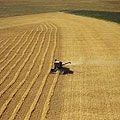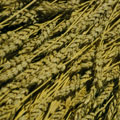|
Agriculture
 The past century has seen the growth
and significant change of a dynamic agricultural
industry in Alberta. The number of farms has decreased,
but the average farm size has increased by more than
two-fold. The area of the agricultural land base has
also changed, increasing by 33 percent from 15.8 million
hectares to 21.0 million hectares, covering about one
third of the area of the province. The past century has seen the growth
and significant change of a dynamic agricultural
industry in Alberta. The number of farms has decreased,
but the average farm size has increased by more than
two-fold. The area of the agricultural land base has
also changed, increasing by 33 percent from 15.8 million
hectares to 21.0 million hectares, covering about one
third of the area of the province.
Mechanized farming and modern
methods, such as the use of chemical fertilizers and
pesticides, have enabled fewer people to do more work
and produce more than was previously possible. Economic
factors have favoured large-scale operations.

Primary agriculture is Alberta's
largest renewable resource-based industry. Alberta
accounts for 25 percent of annual Canadian agricultural
production with only nine percent of Canada's
population. In 1996, primary agriculture generated a
record $6.4 billion in farm cash receipts.
Typically, annual sales of products are about evenly
balanced between crops and livestock. Agricultural
processing, including food and beverage processing
industries, is Alberta's largest manufacturing sector.
Combined, the agricultural production
and processing sectors were the second largest employer
in the province in 1996.
Today, as in the past, agricultural
activity is one of the most dominant uses of land in
Alberta. Most of Alberta's crop and livestock production
takes place on the prairies, which are mostly semi-arid
grasslands and sub-humid aspen parkland in the central
and south central regions of the province. Large farming
areas also occur in the southern part of the boreal
forest, and in the Peace River region of northern
Alberta.
The four major crop categories are
cereals, oilseeds, specialty crops and forages. In 2004,
wheat grossed $934 million in sales while canola seed was
valued at $357 million.
Moisture is the limiting factor to
crop growth in the warmer, drier brown and dark brown
soil zones of southern Alberta. Irrigation is one of the
primary methods of improving agricultural productivity
and diversifying the range of crops grown in this
region.
|  Heritage Community Foundation Presents
Heritage Community Foundation Presents
 Heritage Community Foundation Presents
Heritage Community Foundation Presents